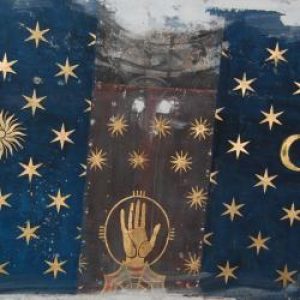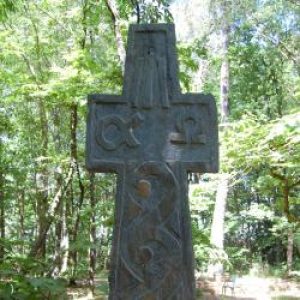A number of members of the Order consider themselves Christian and find no conflict in following the Order’s course and practicing their faith. Although some Pagans believe Druidry and Christianity to be incompatible, due to the repressive and patriarchal attitudes and history of certain forms of Christianity, others are interested in the common ground they share.
The Chief of the Ancient Druid Order was involved in the Universalist Church, just as the Druid Iolo Morganwg was involved in helping promote Unitarianism more than a century earlier. Later these two churches merged and today represent the most liberal and open-minded of all Christian movements, even facilitating Pagan meetings and ceremonies in their churches.
Here we invite you to explore the connections between Druid and Christian spirituality. To begin, we offer here two poems by RoMa Johnson to inspire this exploration, followed by a personal account of how the novelist Barbara Erskine found Druidry helped deepen her faith in Christianity. Then we offer video conversations between a Druid, Philip Carr-Gomm, and a Christian priest, Sean O’Laire, and Amy Dillon who is seeking to combine both paths and is asking important questions about both approaches.
Then we offer essays which delve deeper…
Jesus and Merlin
What if
Jesus and Merlin were to meet
At twilight
In the garden, in the grove,
One looking forward to the Skull of Golgatha,
One looking back on the Sacred Head of Bran?
What would they say to one another,
These men, these gods,
Who live in time beyond their lives –
One forward, one retrograde?
“Let this Cup pass from me…” says the one.
“May the earth open and swallow me,
May the sky fall upon me,
May the sea rise and cover me,
May fires consume me…” says the other.
“Take this cup and drink from it…” says the one.
“This is the Cauldron of Inspiration and Wisdom…” says the other.
“Do this in remembrance…” says the one.
“I know the Cup
From which the wave has overflowed.
I know the end of the dawn…” answers the other.
What if they do meet
There in the grove, in the garden,
Two avatars –
One about to ascend,
One about to descend –
Each serving the Chalice in his way?
What if Merlin’s Afallen and Jesus’ Rood are the same Tree?
One rides it to his destiny,
One sits beneath to prophesy.
What could they give to one another
These prophets circling in their Time-long orbits?
Could Merlin say: “The seed is planted, the tree will grow
There is a thorn in Avalon that bears fruit in thy name.”
Would Jesus reply wistfully: “Kiss Nimue for me.
Tell her I love her beauty and her power.”
RoMa Johnson
Sisters
What if they were to meet
In the cloistered garden, there on Iona,
What would they say to one another?
+ I am the Bride of Christ.
I am the bride of no man.
+ I clothe myself in humility and walk in silence.
I paint my naked body and scream into the wind.
+ I do good works.
I carry a wee knife.
+ I spend most precious hours here among the sacred texts.
I read the ogham of trees, the placement of stars, the auguries of birds.
+ I yearn in passion for the Sacred Heart of Jesus.
I embrace the deep-beating thrum of the stone.
+ I await the soft light of blessedness to imbue me.
I call down the lightning from the dark.
+ I know that I am a child of God.
I am a woman fully grown.
+ My world is within these graceful walls.
My world surrounds yours utterly.
+ I partake of the Body and Blood.
I eat the dripping honeycomb pulled from the hive, the mistletoe pearls cut
in moonlight from the ancient oak.
+ Evening comes; soon bells will ring for prayer in candlelight.
Night comes, stirring the long grass; stars call me to dance among their multitude.
+ I must go in.
I must go out.
+ Farewell, my wild sister. Go with God.
Fare thee well, Sister. In Awen we are one.
RoMa Johnson
Exploring Druidry and Christianity with Amy Dillon, Philip Carr-Gomm and Seán ÓLaoire - Part I
Exploring Druidry and Christianity with Amy Dillon, Philip Carr-Gomm and Seán ÓLaoire - Part II
Exploring Druidry and Christianity with Amy Dillon, Philip Carr-Gomm and Seán ÓLaoire - Part III
DISCOVER MORE
Learn more about Druidry and how to join the order
The practice of Druidry used to be confined to those who could learn from a Druid in person. But now you can take an experience-based course wherever you live, and when you enrol on this course, you join the Order of Bards, Ovates & Druids, and begin an adventure that thousands of people all over the world have taken. It works with the ideas and practices of Druidry in a thoroughly practical, yet also deeply spiritual way.
The novelist Barbara Erskine writes of her experience
‘When I was a child I set up an altar in woodland at the bottom of the garden. on it I put a little gold cross wedged into a lump of plasticine. Now, many years later, I realise this was a first expression of leanings towards what I now recognise as druidic Christianity, or Christian Druidism.
I came from a Church of England family and went to a school which worshipped daily in the chapel. Faith foundered however when I studied history at university. I encountered for the first time Christianity’s downside: it had been too much mediated by politics, cruelty, misogyny and fundamentalism, caring little for Jesus’s teachings of tolerance and love; it seemed to encourage exploitation of the natural world and it used the heavy hand of guilt rather than love to corral its followers. Like many others I questioned and fell away.
When I discovered Druidry it was a homecoming into a philosophy which encompassed all that I held dear and it brought me into the western spiritual tradition, something which had been part of my soul without my realising it. My world was animistic. I had always prayed to the one God and all the gods, feeling that that expressed my true beliefs even though I was not comfortable with wholesale paganism. The last thing I expected was for my studies and meditations to illumine and rekindle my struggling Christian faith. Or that they would reconcile my certainties about a supernatural world of nature spirits, ghosts and energies which seemed to be unchristian, into a church which included angels and archangels and all the company of heaven.
Druidry acted as a change of focus; a personal reinterpretation; an altered attitude. It shone a beam of light into a monochrome landscape and reminded me of an ancient church where Celtic saints had called blessings onto rain-soaked hills, where St Kevin allowed a blackbird to nest on his hand, where Brighid was both goddess and saint, a church where Our Lady was also the Star of the Sea, a blessed feminine warmth which a more puritan faith had distanced. Ancient prayers took on deeper meanings for me. Now the Benedicite read like a Celtic hymn.
The druidical circle of seasons was there within the liturgy, sacred geometry was there, though forgotten by most, as were the healing energies of stone and stained glass and the mysticism of ancient words.
Historians and theologians may find the belief untenable but I like the idea of long-ago druids segueing neatly with the changing focus of the heavens into a Celtic Christianity. It feels right.
My practice of meditation evolved naturally back into one of regular prayer and though prayer can happen every- and any where I set up a small altar of my own again. In its centre I have a beautiful statue made by a friend, of the Blessed Virgin, not a meek, mild obedient role model, but Queen of Heaven, with crown and royal robes. On her knee is the Christ child. At the four corners of the altar I have put symbols of earth air fire and water. There is a Celtic cross there, and flowers. Sometimes I have incense. Sometimes meditation oils. Sometimes this is the centre of my druid rituals. I use it as a place to pray, to meditate and to listen. Unorthodox? Probably. But it makes perfect sense to me.’
Barbara Erskine








